Retro Review: The Magazine of Fantasy & Science Fiction, June 1955
The Magazine of Fantasy and Science Fiction, June 1955. Cover by George Salter
By 1955 J. Francis McComas had resigned as co-editor of F&SF, and Anthony Boucher was sole editor. George Salter remained art director. Both Boucher and Salter left the magazine in 1958. This issue also has a cover by Salter — his last but one for the magazine — he did one more in 1966. I really enjoy Salter’s work, and I learned today that he did the covers for such significant works as the first editions of The City and the Stars, Atlas Shrugged, and A Fine and Private Place. He also shares a birthday with me.
The stories this issue:
“You’re Another,” by Damon Knight (1,1300 words)
“Created He Them,” by Alice Eleanor Jones (3,600 words)
“The Soul of Laploshka,” by Saki (1,700 words)
“The Adventure of the Ball of Nostradamus,” by August Derleth and Mack Reynolds (4,200 words)
“The Faithful Friend,” by Evelyn E. Smith (4,700 words)
“Astronomy Lesson,” by Willard Marsh (3,600 words)
“Walk Like a Mountain,” by Manly Wade Wellman (5,600 words)
“A Slice of Life,” by P. G. Wodehouse (5,000 words)
“The New Sound,” by Charles Beaumont (1,800 words)
“Artifact,” by Chad Oliver (8,000 words)
(There are also two “departments”: Recommended Reading, by Boucher; and an Index of the first 6 months of 1955. There is one short poem, “Survival,” by Carlyn Coffin. Recommended Reading discusses the Disney program Man in Space, plus a couple of nonfiction works about Mars, and a few novels: his highest praise is reserved for Leonard Wibberley’s The Mouse That Roared. Coffin’s quatrain is a dark meditation on the aftermath of atomic war.)
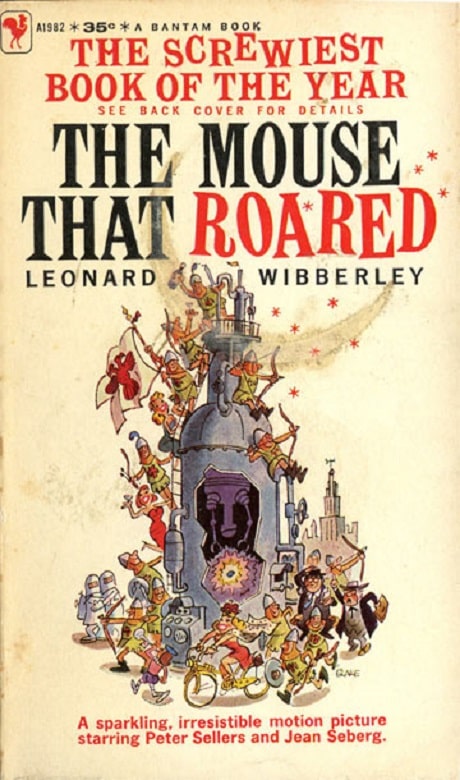 |
 |
The Mouse That Roared (Bantam Books)
The issue opens very strongly with a remarkable story by Damon Knight — a story I shockingly had not yet read, despite recommendations from the likes of Todd Mason, and despite a lingering impression I had once read it — but I’m now sure I had not. Johnny Bornish is a young painter who we meet having chaotic things happen to him — a dog knocks him into a pool, he spills paint in an art store, he breaks the coffee dispenser at an automat. He also notices a couple of strange people who seem present whenever this stuff happens… and he remembers them from past incidents. Feeling paranoiac, he retreats to his rooms, where his roommate offers him a loan to get out of town and away from trouble. But strange things happen at the plane terminal as well — and then, somehow, he recognizes the man next to him on the plane — one of his tormentors. And he decides to take things into his own hands… it’s a wild story, at times madcap but with a dark side, and a great snap ending.
“Created He Them” is one of only five SF stories by Alice Eleanor Jones, a Ph.D. in English who left her career when she married fellow Ph.D. Homer Nearing and had children. Nearing was also an occasional F&SF contributor. Jones wrote widely, both fiction and articles, for such magazines as Redbook, Ladies’ Home Journal, Seventeen, etc. — back when those were important fiction markets. “Created He Them” was her only F&SF appearance, and it’s probably her best regarded story.
It’s set in what seems a post-apocalyptic future. Ann Crothers is married to an apparently somewhat abusive man, and she has two children. Life seems constrained, lots of rationing. She takes the children out for a walk, and the women in the neighborhood flock around her. Slowly we realize her children are the only children around — the other women pay her to be allowed to hold them — and then we learn that she and her husband had other children, taken by the government when they get old enough, and that she’s trapped with a man she detests because they are interfertile. It’s a quiet, near despairing piece, and quite effective.
Saki’s real name of course was H. H. Munro (1870-1916). He was born in Myanmar (then Burma, which was part of British India back then) and raised in England. His first cousin was the novelist Dornford Yates (real name Cecil Mercer.) He made a name for himself with his often sardonic and twisty short stories, and enlisted in the British Army in World War I, despite his age. He was killed in action in 1916, supposedly as he was growling at another soldier “Put that damned cigarette out!”
“The Soul of Laploshka,” which was first published in the Westminster Gazette (one of Saki’s primary markets) in 1909, is a fairly minor piece. The narrator tells of his old acquaintance Laploshka, the “meanest” (meaning cheapest) man he knew — who would happily give money to the rich in hopes of favor, but would never contribute to charitable causes. The narrator plays a trick on Laploshka and ends up with two francs of his, which he gives to a church… and Laploshka soon dies but still haunts the narrator until he finds a way to retrieve the money and give it to a more deserving, i.e. richer, man. It read somewhat strained to me.
August Derleth is mostly remembered now for keeping H. P. Lovecraft in the public eye after his death, especially by founding Arkham House to collect his stories in book form. Derleth also wrote some Lovecraft-derived fiction, and even did some posthumous “collaboration” by turning some of Lovecraft’s fragments into full stories. But Derleth was more than just a Lovecraftian — he wrote widely, and he was a Sherlock Holmes enthusiast. He created the detective Solar Pons as a sort of Holmes substitute, and wrote a great many stories about him. “The Adventure of the Ball of Nostradamus” is a Solar Pons story.
So what’s up with this story by Derleth with Mack Reynolds, who was very early in his writing career? How did Reynolds come to collaborate with Derleth? I asked Bob Byrne, a Derleth aficionado, and he had the answer. Reynolds had submitted a story to F&SF that was an attempt to portray Sherlock Holmes being visited by a time traveler. But it didn’t really work — Reynolds hadn’t done a good job of portraying Holmes and Watson, and couldn’t mention them by name because the Arthur Conan Doyle estate frowned on that. But Boucher and McComas had an idea — why not see if August Derleth would take Reynolds’ story and rework it as a Solar Pons piece? Derleth happily agreed. This was “The Adventure of the Snitch in Time” (F&SF, July 1953).
The Final Adventures of Solar Pons (The Battered Silicon Dispatch
Box & Mycroft & Moran, 1998). Cover by Jean-Pierre Cagnat
Reynolds had another idea for a story, and he and Derleth wrote “The Adventure of the Ball of Nostradamus.” They planned to keep writing them, for regular publication in F&SF, but in the end only finished two more (“The Adventure of the Nosferatu” and “The Adventure of the Extra-Terrestrial”), and those stories weren’t published until after both writers had died, in The Final Adventures of Solar Pons.
Curiously, Reynolds took the idea for one of those later stories and reworked it to be a Holmes story, and it was published in the July 1965 Analog as “The Adventure of the Extraterrestrial.” Bob’s full account of these stories can be found here.
As for “The Adventure of the Ball of Nostradamus,” it concerns a series of shocking killings of young children, all around Europe. There is no obvious connection between the children. But the police think they know the killer — a notorious criminal that they arrested and interrogated, only to have to shoot him as he tries to escape. They come to Pons with the incoherent results of the interrogation — and Pons, suspicious of the dead man’s guilt, finds a hint in a reference to a fortune teller. So they visit the most notorious fortune teller in London — who proves his skills by being ready for the visit, and he tells Pons a truly incredible story. I won’t reveal the conclusion, only say that Pons is left very disturbed after the successful end of his investigation. It’s a worthwhile idea, fairly well done, though I think as a detective story it would have been better with another twist or two. As a moral fable of sorts, it’s the right length.
Evelyn E. Smith was a prolific contributor to the SF magazines in the ’50s and early ’60s, before turning mostly to gothics in the 1960s (as by “Delphine C. Lyons,”) and then a popular mystery series in the ’80s, the Miss Melville novels. She did publish three SF novels, one each in the ’60s, ’70s, and ’80s. Her fiction is quite enjoyable, and I think she’s a writer whose SF contributions deserve a closer look.
“The Faithful Friend” is a dark look at an alien invasion — rather darker than most of Smith’s work. The aliens have taken over, and are using humans as pets. An ambitious young alien, Krayn, is ready to take over for the aging Governor Gorys, and he is suspicious of what he sees as Gorys’ soft attitude towards humans, especially his belief that they are intelligent, and can communicate using sound, instead of telepathy like the aliens. George, secretly, is also helping a group of feral humans… then the crisis comes, when the feral humans plan an attack on Gorys’ estate. What will George do? The conclusion is bitterly ironic. A fine story.
“Astronomy Lesson” is a story Boucher plucked from the Yale Review, where it was first published (in 1954). Willard Marsh (1922-1970) was a prolific contributor to the “little” magazines, after serving in the War. He received degrees in 1959/1960 from the University of Iowa Writers’ workshop, and after that taught at several universities — Winthrop in South Carolina, Southern Cal, North Texas State. He seems to have had a fair amount of success — stories in the O. Henry anthologies plus Martha Foley’s legendary series. After this story was published he sent a few more stories to F&SF, and a couple to Fred Pohl’s magazines in the mid-60s.
“Astronomy Lesson” is a brief piece in more of a magical realist mode, perhaps. A couple of lonely people bump into each other at the theater, walk home… start to feel an attraction developing, and they see a falling star. Lucky, eh? — but they find where it actually fell, and pick it up, and their reactions — well, really, the young man’s reactions in the long run — turn things sour. It’s an effective if rather bitter little piece, with the slight fantastical element nicely used.
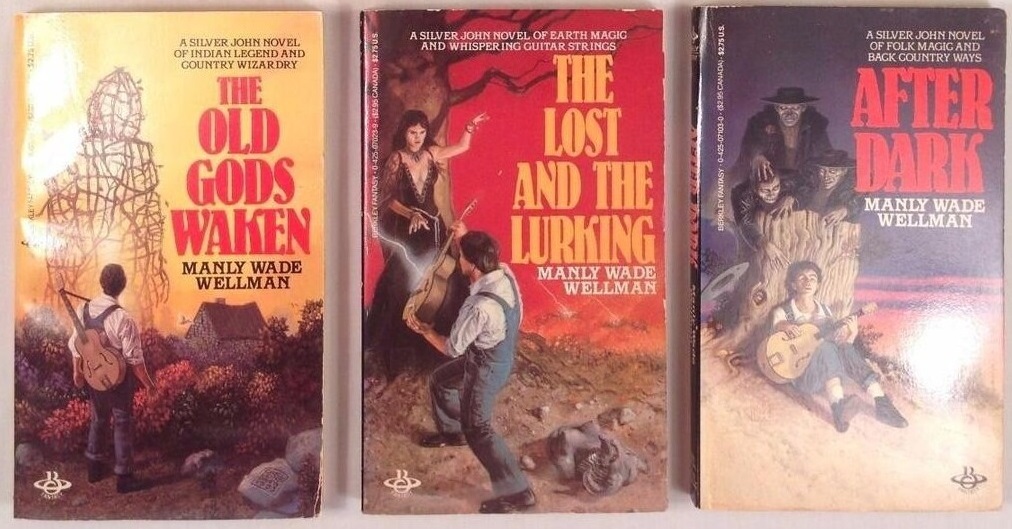 |
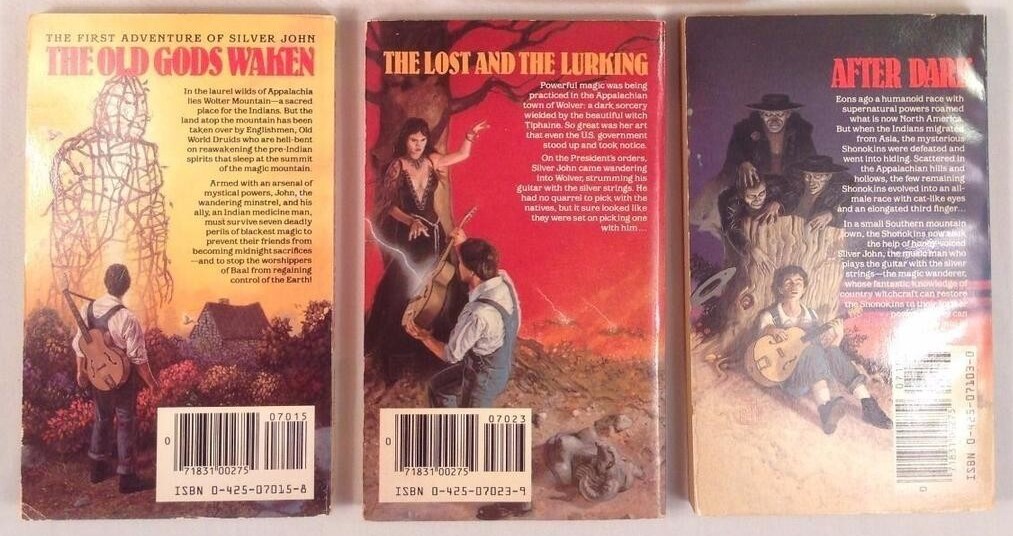 |
The John the Balladeer collections: The Old Gods Waken, The Lost and the Lurking,
After Dark (Berkley Books, 1984). Covers by Carl Lundgren
Manly Wade Wellman wrote five novels and a couple dozen at least stories about John the Balladeer, or Silver John, who wandered around the Appalachian mountains, singing for his keep. I haven’t read a lot of them. “Walk Like a Mountain” is one of the earlier ones, and it is a pretty nice story. John comes to the very isolated Sky Notch with some money for Lane Jarrett — but Lane Jarrett has other problems. His daughter Page has been carried off by a giant — that is, a very tall man, but, the story hints, maybe his ancestors were “giants in the earth in those days.” (And Page is a very tall young woman, perhaps explaining his attraction to her!)
Rafe Enoch, the giant in question, is pretty mad at the people in Sky Notch, and John heads up to his place to try to calm him down. Alas, a storm is coming, and Rafe’s planned a pretty severe revenge on Sky Notch. John (and Page) have to scramble to figure out how to stop Rafe. Besides the well-done plot, Wellman’s handling of Appalachian slang works very well (I assume it’s spot on, but I wouldn’t know.)
“A Slice of Life” is a Mr. Mulliner story — P. G. Wodehouse wrote over 40 of these. They are bar stories, in which Mr. Mulliner insists that his fellow drinkers hear a story about one of his many relatives — often about their success in business, and also often about their success (or not) in love. This is a prime example (and it’s the second one written, apparently): Wilfred Mulliner, who markets a whole series of useful treatments, falls for Angela, but Angela’s guardian wants her to marry someone else. Angela loves Wilfred — until one of his potions ruins her complexion, and she breaks it off. But Wilfred assumes her guardian has faked the breakup letter, and disguises himself as a servant… needless to say, after complications, some further products Wilfred can supply to cure Angela’s issues, as well as helping her guardian, and true love (or commerce) succeeds! Amusing enough, though for me the Mulliner stories aren’t as fun as Wodehouse’s more famous work.
“The New Sound” is a clever and dark piece from Charles Beaumont. Beaumont was primarily a dark fantasy writer, who published regularly in genre magazines and in the slicks, and also wrote for television. (He wrote the first story Playboy ever published.) He was well-regarded, but he doesn’t seem as well remembered these days, perhaps because he died very young (at 38) of an unusual disease, possibly very early onset Alzheimer’s. “The New Sound” is about a collector, who narrows and narrows his obsession until he only collects the sounds of some creature dying — ending up in humans, and, finally, the most unique such sound.
The last story is Chad Oliver’s “Artifact.” An expedition to Mars discovers an incredible artifact: a stone knife, similar to those made by early humans. Dr. Dixon Sanders, an archaeologist, is recruited to make the return trip to Mars to properly study it, and see if any more such tools can be found, and any evidence of how they got there. What he finds is truly remarkable… and, in Oliver’s hands, hopeful and powerful. Another good story in what I think is one of the better early F&SF issues.
Rich Horton’s last article for us was a Retro-Review of the April 1952 issue of The Magazine of Fantasy and Science Fiction. His website is Strange at Ecbatan. Rich has written exactly 200 previous articles for Black Gate, see them all here.
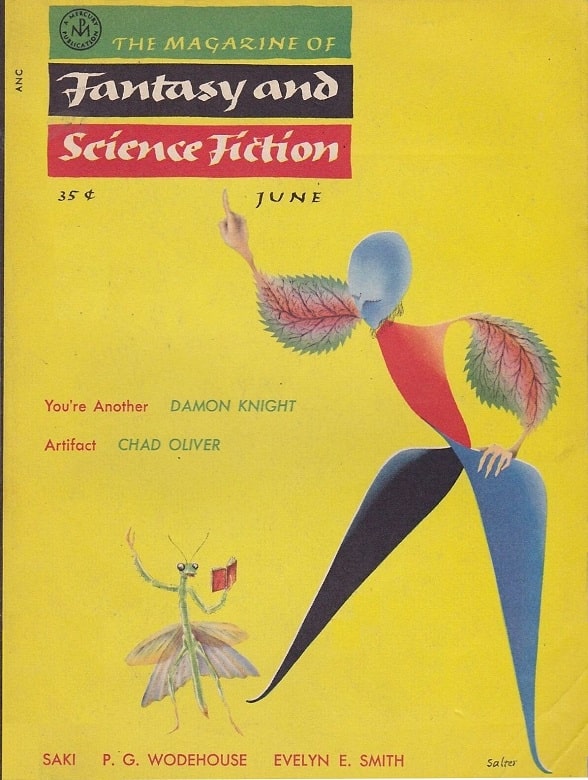
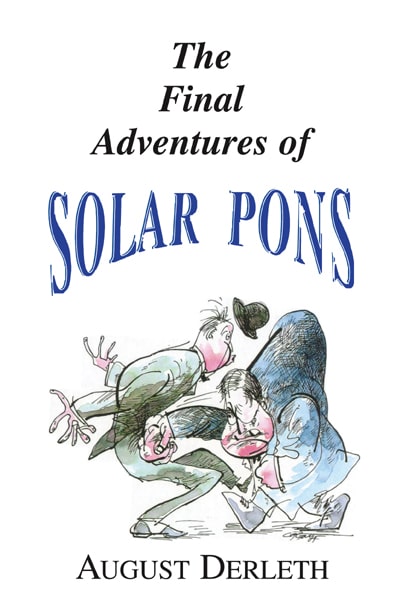
Love these Retro-Reviews. It seems F&SF used a lot of reprints in these early days. When did they switch over to mostly new work?
I should look into that more closely. My suspicion is that the inflection point might have been when Boucher left and Mills took over. (1958 I think?) Though F&SF to this day published occasional reprints, more than the other digests.
Rich, this is a great issue! Huge fan of the Jones story — which I rate a “lost” masterpiece. And I should have a review up of the Damon Knight story (in a collection I read of his) up by next weekend.